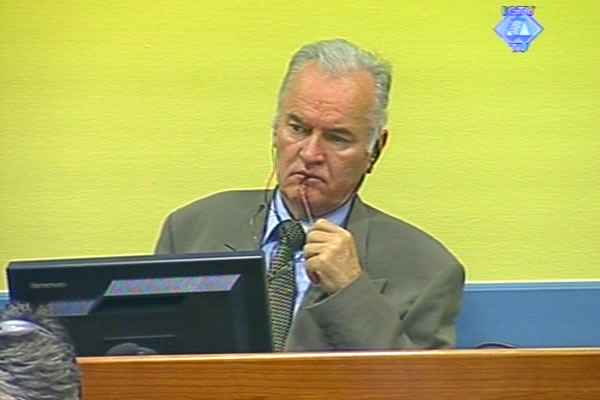Home
‘TYPICAL TERRORISM’ IN SARAJEVO
Dragan Miokovic, an investigator from Sarajevo, was involved in a number of crime scene investigations of artillery and sniper attacks on civilians during the siege of the city. Miokovic said that the army under the command of the accused Ratko Mladic meant to cause fear and panic among the population in order to achieve military and political goals. This, in Miokovic’s words, is a ‘typical characteristic of terrorism’
 Ratko Mladic in the courtroom
Ratko Mladic in the courtroom During the siege of Sarajevo, Dragan Miokovic was an inspector in the city’s Security Services Center. From December 1993 to the end of 1995, Miokovic took part in the crime scene investigations of more than a hundred artillery and about a hundred sniper incidents. Among them are several incidents listed in the indictment against Ratko Mladic. Miokovic, an ethnic Serb, says that during the siege there were about 20 to 25 per cent of non-Muslim employees in the Sarajevo police. Miokovic did not testify under a pseudonym but was granted image protection.
The three statements the witness gave to the OTP investigators in The Hague were admitted into evidence. In the statements, the witness described in detail several investigations he had attended. The first incident Miokovic described was the artillery attack in Livanjska Street on 8 November 1994. A young girl was killed; half an hour later a woman was killed when two artillery shells were fired at the same target. Miokovic said that he and his colleagues from the investigation team established that all three shells were fired from the positions of the Republika Srpska Army (VRS).
The witness also described the crime scene investigation of two sniper attacks on a tram in Zmaja od Bosne Street on 23 November 1994. A civilian was killed and five were wounded in the attack. The witness also mentioned the incident of 3 May 1995 when several passengers were wounded in a tram on the corner of Zmaja od Bosne and Franje Rackoga Street. As Miokovic said, it was established beyond doubt in both cases that the snipers had opened fire from Grbavica, which was under the control of Mladic’s army.
After the war, the witness and the Sarajevo police investigation team went to the buildings in Grbavica. In just one of the four skyscrapers from which fire had been opened, the witness found about ten sniper nests. The prosecutor showed several photos of a sniper position fortified with sandbags and with an opening with a line of vision to Zmaja od Bosne Street. Detailed documents of crime scene investigations with the reports filed by investigators and crime scene technicians, photos, witness statements and medical reports were admitted into evidence.
The witness said that the trams in Sarajevo were operating mainly on the days when ceasefire was in force between the BH Army and the VRS. They were used mostly by the elderly and women who had to get ‘the bare necessities’ in the shops. According to the witness, those were the periods when the situation ‘at least started resembling normal’. As a rule, these periods didn’t last: before long, civilians would be killed or wounded.
As Miokovic explained, the objective of the Bosnian Serb army actions was to spread ‘fear and panic among the population’ in order to ‘accomplish a military or political goal’. This, Miokovic said, was a ‘typical characteristic of terrorism’. Miokovic described the Bosnian Serb army as an ‘aggressor force’.
Before the Sarajevo investigator took the stand, the defense completed the cross-examination of Canadian general David Fraser. Mladic’s defense will cross-examine Miokovic on Monday.
Linked Reports
- Case : Karadzic
- 2012-12-06 DID BATKO HAVE POLITICAL BACKING?
- 2012-12-05 KARADZIC’S WITNESS: MUSLIMS LEFT PALE VOLUNTARILY
- 2012-12-04 VIEW FROM METALKA BUILDING
- 2012-12-11 WHAT ARE THE ‘MOST PROFITABLE’ TARGETS?
- 2012-12-12 WITNESSES DEFEND KARADZIC AND THEMSELVES
- 2012-12-13 WITNESS ORDERED HIS SOLDIERS TO USE BOMBS HE KNEW NOTHING ABOUT
